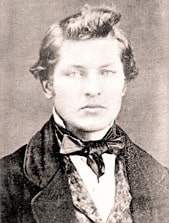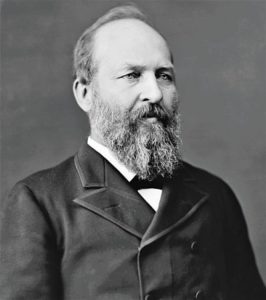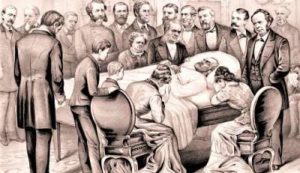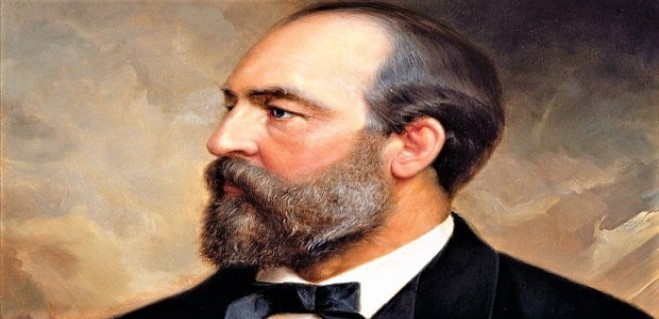James A. Garfield is also known as James Abram Garfield (Orange, Ohio, 19 of November of 1831 – Long Branch, New Jersey, 19 of September of 1881) was the 20th President of the United States. He became the second president assassinated in the United States – Abraham Lincoln had suffered the same fatality, also while in office.
His presidency is the second shortest in United States history, after that of William Henry Harrison, lasting only six months and fifteen days.
Quick Facts: James A. Garfield
- Known for: 20th President of the United States
- Born: November 19, 1831, in Cuyahoga County, Ohio
- Parents: Abram Garfield, Eliza Ballou Garfield
- Died: September 19, 1881, in Elberon, New Jersey
- Education: Williams College
- Spouse: Lucretia Rudolph
- Children: seven; two died in childhood
Early Years of James A. Garfield
James Garfield was born on November 19, 1831, in Cuyahoga County near the present city of Orange in Ohio; he was the youngest in a family of five children. His father, Abram Garfield, known locally for his wrestling activities, died when James was only 18 months.
Of Welsh descent, he was raised by his mother, Eliza Ballou who claimed that he was the biggest baby I had and he looked like a red Irishman. Garfield’s parents had joined the disciples of Christ and these deeply influenced boys. Garfield received a rudimentary education at the village school in Orange.
He knew, however, that he would need money to continue his studies. At the age of 16, he decided to stand on his own two feet and turned to the sea in the hope of becoming a sailor; however, it obtained a worker working on a canal near Cleveland for six weeks.
He fell ill and returned home but after recovering he attended during the Geauga Academy where he discovered a passion for learning. Garfield worked as a carpenter, ringer bell, and concierge to finance his studies.

He later said about this period: I am sad to have been born in poverty and in this chaos of childhood, 17 years passed before I found any inspiration… 17 precious years during which a boy with a father and a little money would have could be fixed in various manly ways. In 1849, he accepted a teaching position that did not suit him and then developed an aversion to what he called the “job search” which became in his “law of my life”.
In 1850 Garfield returned to the church and was baptized.
Education
From 1851 to 1854, he studied at the Western Reserve Eclectic Institute (later renamed Hiram College) in Hiram, Ohio. At Eclectic, he became interested in the study of Greek and Latin 11 and began to teach.
He is on the other hand, the ability to write simultaneously in Latin with one hand and in Greek on the other. He made many preaching tours in nearby churches, sometimes earning a dollar per religious service.
James A. Garfield then enrolled at Williams College in Williamstown in Massachusetts where he joined the fraternity Delta Upsilon. Garfield was impressed by the president of the university, Mark Hopkins, about whom he said, The ideal education is Mark Hopkins at the end of a stump and a student on the other side.
James A. Garfield earned a reputation as a gifted debater and became president of the Philogian Society and editor of the Williams Quarterly. After a remarkable career, he graduated in 1856.
After briefly preached Franklin Circle Christian Church, Garfield abandoned this vocation and postulated the headmaster post of High School Poestenkill in the New York. He was not retained and returned to teach at the Eclectic Institute.
He taught classical literature during the university year from 1856-1857 before becoming headmaster of the Institute from 1857 to 1860; he managed to restore the attractiveness of the school, which had declined.
At that time James A. Garfield came close to the ideas of moderate Republicans even if he was not a party man. If he did not consider himself an abolitionist, he was against slavery. After finishing his studies, he began a career in politics, making many speeches committed in favor of the Republican Party and their anti-slavery cause.
In 1858, an atheist and supporter of evolutionism named Denton launched into a debate with him ( The Origin of Charles Darwin’s species was published the following year). The debate, which lasted more than a week, was considered to have been won by Garfield.
James A. Garfield Marriage with Lucretia Garfield
First love James A. Garfield was Mary Hubbell in 1851 but the relationship lasted a year without formal commitment. November 11, 1858, he married Lucretia Rudolph who was one of his former students.
They had seven children (five sons and two lines): Eliza Arabella Garfield (1860-1863); Harry Augustus Garfield (1863-1942); James Rudolph Garfield (1865-1950); Mary Garfield (1867-1947); Irvin M. Garfield (1870-1951); Abram Garfield (1872-1958) and Edward Garfield (1874-76).
James A. Garfield also entered politics and became Secretary of the Interior to President Theodore Roosevelt.
Early Career
James A. Garfield gradually lost interest in teaching and began studying law in 1859. He was admitted to the Ohio bar in 1861. Before admission, he was invited to enter politics by local Republican leaders and to report to the state Senate seat for the 26th Ohio District after the death of Cyrus Prentiss who held this position.
He was appointed by the party convention and was elected state senator in 1859 until 1861. The most significant act of his mandate was the drafting of a law intended to carry out the first geological study of the State in order to determine its mineral resources. As the nation approached the civil War, Garfield considered secession to be inconceivable.

His response was renewed zeal for the celebrations of July 4, 1860. After the election of Abraham Lincoln, Garfield longer thought to be armed to negotiate and said other states may be armed to the teeth but if Ohio cleans his rusty muskets, they say that his offense brothers from the South.
I am tired of this weakness. February 13, 1861, the newly elected President Lincoln arrived in Cincinnati by train to give a speech. Garfield noted that Lincoln was desperately modest but had nevertheless the tone and the stature of a man strong and fearless.
Election as Candidate
James A. Garfield was elected a candidate by the Republican Party in June 1880 at a convention held in Chicago in which James A. Garfield knew how to take advantage of the rivalry between the great favorites for the Republican candidacy, James G. Blaine, leader of the “mestizo” Republicans (so-called because their rivals considered them semi-Democrats), moderate Republican candidate John Sherman and former President Ulysses S. Grant, the favorite candidate of the most radical sector of the party, the most opposed to agreements or pacts with the Democrats or with the South.
After no less than 35 votes in which none of the candidates prevailed (such as the internal division in the party), the convention opted for a dark horse That is, a semi-unknown candidate who was not on the favorites list, and that is that Garfield’s maneuvers in favor of General Sherman made the convention see him as an ideal candidate for the presidency.
James A. Garfield, with staunch New Yorker Chester Arthur as a vice presidential candidate, beat Democratic rival Winfield Scott Hancock in the election with 214 electoral votes to 85 and a slim margin of 10,000 votes. He was invested on March 4, 1881.
Presidency of James A. Garfield
Garfield’s brief presidency was conditioned by the great enmity he contracted with the Conkling stalwarts, by refusing to provide them with the rewards and perks of all kinds that awaited their political backing at the Convention, as has been standard practice since the days of President Ulysses S. Grant.
For Conkling and his stalwarts, Garfield’s fight against the spoil system was treason, being a cause inherited from the previous president, Rutherford Hayes, whom the stalwarts detested.
But the confrontation became more virulent when Garfield appointed James G. Blaine, Conkling’s great enemy, secretary of state, and another prominent Republican to fill the lucrative post of director of New York Harbor customs offices.
Conkling and Thomas Platt, also a Republican senator from New York, questioned in Congress the presidential right to appoint positions in New York, citing the senatorial tradition of voting for presidential appointments in their respective states.
Both politicians abandoned their seats in Congress to run for the New York Assembly and thus put pressure on Garfield to back out of that appointment. But the Assembly, in a very unusual act of independence, removed the political couple and sent two new members to Washington, stalwart.
The Assassination of James A. Garfield
On July 2, 1881, Charles J. Guiteau, a mentally impaired office seeker, shot Garfield in the back in Washington, DC, train station while on his way to a family vacation in New England. The president lived until September 19 this year.
Guiteau was apparently driven by politics to tell the police after he gave up, “Arthur now President of the United States.” He was convicted of murder and hanged on June 30, 1882.
The cause of death was massive bleeding and slow blood poisoning, which was later described as more related to the unsanitary manner doctors treated to the president than to the wounds themselves.

Physicians of the time were untrained in the role of hygiene in preventing infection. The standard procedure was to devote most of the treatment effort to remove the bullet, and several doctors repeatedly stubbed his wound in an unsuccessful search.
Heritage
James A. Garfield served the second shortest term in American history, topped only by the 31-day term of William Henry Harrison, the ninth president who caught a cold that turned into fatal pneumonia. Garfield was buried in Lake View Cemetery in Cleveland. After his death, Vice President Arthur became President.
Because of Garfield’s short term in office, he can’t do much as President. But by investigating the mail scandal, despite its impact on members of his own party, Garfield paved the way for public service reform.
He was also a pioneer of African-American rights, believing that education was the best hope of improving their lives. In his inaugural speech, he said:
“The elevation of the negro race from slavery to full civil rights is the most important political change that we have seen since the adoption of the constitution of 1787. It could not have been a thoughtful man who did not appreciate its beneficial effects on our institutions and people. … it has the master as well as the slave from a relationship that both freed harmed and weakened. ”
Garfield’s prolonged death is credited with the help of establishing the American president as a celebrity. The public and media of the day were described as obsessed with his long walk, all the more so than it had been 16 years since President Abraham Lincoln was murdered.

